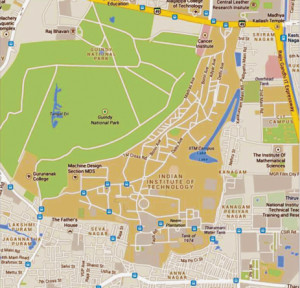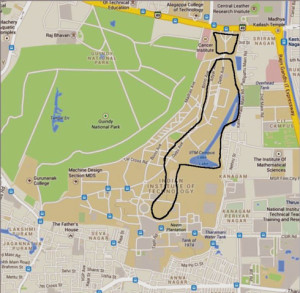Registered with the Registrar of Newspapers for India under R.N.I 53640/91
Vol. XXVIII No. 17, December 16-31, 2018
IIT-M campus – Then & Now
Krishnamoorthy Venkatesh reporting on a lecture by Prof. P. Sriram of IIT-M.

The campus today (above) and below: the extent of old lake.


When a proposal for establishing a higher technological institute was made by the Union Government in 1958, the Madras Government allocated 276 acres of plain land and 131 acres of lake area in the Guindy National Park for it. After initial demarcation of the land, the Conservator of Forests in charge of the Guindy Park asked the Government to keep an area called Appalakulam (a pond) in the forest, which served as a watering hole for wild life. In response, the Government redrew the demarcation, leaving Appalakulam with the Guindy Park. So, the lake area given to Madras-IIT was reduced to 110 acres. An area of 386 acres from the Guindy National Park, which extended to 1268 acres, went to the institute eventually.
The lake area forms the main entrance to the campus now and extends well into Delhi Avenue, which leads to the main administrative and academic zone. The bund of the erstwhile lake is along Bonn Avenue, according to the map drawn by Prof. P. Sriram, Head, Aerospace Engineering at IIT-Madras. In 1961, about 200 acres of the new campus around this lake area was submerged during the monsoon.
The campus is divided into four distinct zones: the residential zone (where residential quarters are located), the administrative and academic zone, the hostel zone and a green zone. Nearly one-fourth of the campus is in the green zone with nothing built in it. The large lake is in the green zone but has vastly shrunk in size. The smaller lake is now behind Peeliamman Temple and has been deepened to stay filled with water for the entire year. Even beyond the green zone, a vast tree cover exists across the campus.
Another 223 acres of land, on the southern side, largely used for cultivation, was acquired from the villages of Kanagam and Velacheri in Chingleput District, in 1958. The academic and hostel zones are situated on this land now. The compensation provided to the farmers ranged between Rs. 4 (for dry lands) and Rs. 10 (for wet lands) per cent, and the village sites in Kanagam and Chinna Kanagam were given a compensation of Rs. 25. A new village called Taramani was created in which new houses were constructed for the relocated people. The total cost of acquisition was around Rs. 3.47 lakh.
Another round of land acquisition was made a few years later by the State Government for the future expansion of IIT. The acquired land, about 300 acres in extent, is around the Central Polytechnic and Taramani Link Road area and these were cultivable lands irrigated by the shallow lake that the Madras Government had made over to the IIT. The flourishing fields across the Buckingham Canal (further east of the campus in the present-day Kasturba Nagar and Indira Nagar) commanded at least 10 times higher price. The CSIR complex, the IIT-M Research Park, the Ramanujan IT Park and a part of TIDEL Park occupy the extended land originally meant for the IIT’s expansion.
As the city limits ended in Guindy, part of the campus was situated in Chingleput District until Velachery and Taramani were brought within Chennai’s fold. This division of campus led to jurisdictional problems of police limits, with the hostel zone coming under the Chingleput District and the administrative block falling within in the Madras District. The forest land was de-notified in the Fort St. George Gazette only in 1961, but construction of the hostels and academic buildings had started in 1959.
The green campus
Prof. Sriram’s recent talk centered on how the campus was greened over time. There were 10,000 trees in 1965. Today, 45,000 plus trees flourish according to a census on the species and their location recorded by the institute. The trees are also numbered for identification. When the land was given to IIT, the forest in the Guindy Park was not thickly wooded, as widely spaced palm trees dotted the area. In fact, the Guindy forest area itself resembled a giant palm grove, said Prof. Sriram.
“We have run out of space in the present campus,” said Prof. Sriram. For further expansion, 150 acres have been acquired by IIT-Madras at Thaiyur on the Kelambakkam-Vandalur highway. The new campus has been fenced and work is ongoing on to develop the campus. Research facilities are likely to come up there.
When the US government declassified spy plane images it acquired during the height of the Cold War, Prof. Sriram was able to get the images of IIT-Madras shot from a U2 spy plane (which hovered around at a height of 70,000 feet above the earth) in 1965. In fact, he also has a nice image of the T’ Nagar area during that period. A vast brown patch of land on the campus is seen in the image as it existed in 1965 and a thick green cover has fallen over the same area at present as seen from Google Earth images. In fact, a photograph of the hostel area shot in 1965 atop the Ganga Hostel shows a vast empty land without any vegetation opposite the hostel, except for two palm trees, one of which still survives as a stump after its top was blown away during the Vardah cyclone. The hostel buildings with two floors as it existed then can be seen in that photograph. Prof. Sriram also showed, using the satellite images from Google Earth, other areas in the campus that have been greened over the years. “We have done a wonderful job of greening this space,” he said.
The initial strength at IITM was 120 students. For two years after formation, classes were held in the AC College of Technology. The girl students were put up in Teachers’ Training College hostel in Saidapet and boys in Pachaiyappa’s Trainees Hostel for men in Guindy. The second batch of students began to occupy the hostel in campus which was constructed by the CPWD. All hostels inside the IIT-M campus are named after rivers. Now there are 9,000 students in the campus and the operational expenditure per year is Rs. 600 crore. The revenue by way of student fee forms only 5 per cent of Institute’s operational expenditure, said Prof. Sriram.


Pingback: When Rewilding Urban Ecosystems, Ask What an Invasive Species Is – The Wire Science – https://bhartiyanews24x7.com